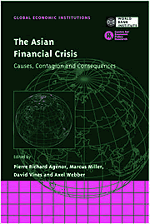Book contents
- Frontmatter
- Contents
- List of figures
- List of tables
- Preface
- List of conference participants
- Acknowledgements
- List of abbreviations and acronyms
- Introduction
- Part One General Accounts
- Part Two Theoretical Contributions
- Part Three Contagion
- 8 Contagion: monsoonal effects, spillovers and jumps between multiple equilibria
- Discussion
- 9 Contagion and trade: why are currency crises regional?
- Discussion
- 10 Competition, complementarity and contagion in East Asia
- Discussion
- Part Four Policy Responses
- Index
8 - Contagion: monsoonal effects, spillovers and jumps between multiple equilibria
from Part Three - Contagion
Published online by Cambridge University Press: 26 February 2010
- Frontmatter
- Contents
- List of figures
- List of tables
- Preface
- List of conference participants
- Acknowledgements
- List of abbreviations and acronyms
- Introduction
- Part One General Accounts
- Part Two Theoretical Contributions
- Part Three Contagion
- 8 Contagion: monsoonal effects, spillovers and jumps between multiple equilibria
- Discussion
- 9 Contagion and trade: why are currency crises regional?
- Discussion
- 10 Competition, complementarity and contagion in East Asia
- Discussion
- Part Four Policy Responses
- Index
Summary
Introduction
Since the crisis in Mexico in late 1994 and early 1995, which was accompanied by speculative pressures in other countries of Latin America and elsewhere, there has been much discussion of contagion effects. Studies by Gerlach and Smets (1995); Sachs, Tornell, and Velasco (1996a); Valdés (1996); and Agénor and Aizenman (1997) present explanations of why a crisis in one country might trigger a crisis in another. Eichengreen, Rose and Wyplosz (1996), using data for 20 industrial countries from 1959–93, show that the occurrence of crises elsewhere increases the probability of a crisis occurring in a given country, after allowing for the standard set of macroeconomic fundamentals. They also attempt to identify what features of countries explain such contagion effects, finding that it is trade linkages, rather than similarity of macroeconomic fundamentals, that have the greatest explanatory power. We will follow them in defining ‘exchange rate crises’ broadly, to include not only devaluations but also successful defence of a peg that involves substantial increases in interest rates and losses of reserves.
The crisis in Thailand and other emerging market economies has once again raised the question of contagion effects. The Thai economy had for several years experienced a period of strong domestic demand associated with an appreciating real exchange rate and large current account deficits, as well as financial sector problems linked to over-exposure to a property market whose prices had fallen sharply. After long resisting pressures on the baht through measures that included capital controls and massive forward intervention, the Thai authorities were eventually forced to abandon the dollar exchange rate peg in July 1997.
- Type
- Chapter
- Information
- The Asian Financial CrisisCauses, Contagion and Consequences, pp. 265 - 280Publisher: Cambridge University PressPrint publication year: 1999
- 48
- Cited by



